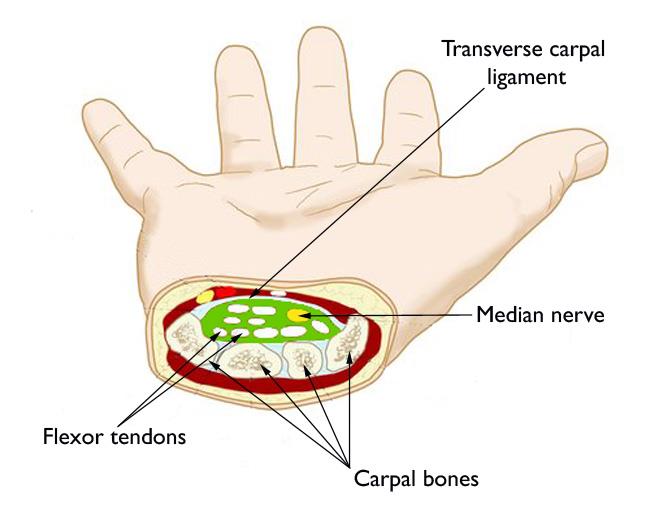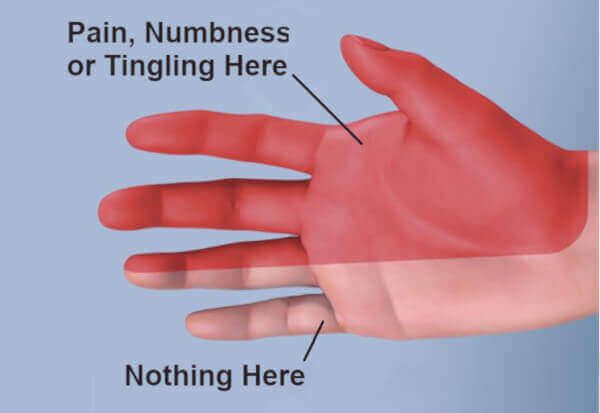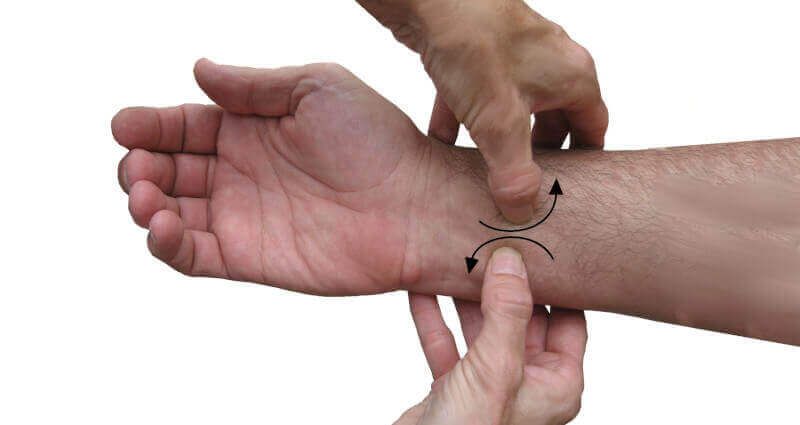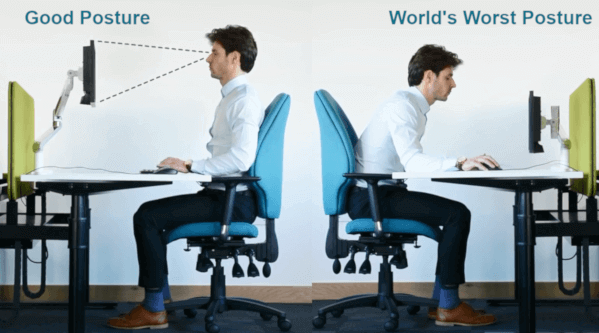How Carpal Tunnel is Treated Without Surgery
From Dr. Z - Carpal tunnel syndrome specialist
How Carpal Tunnel is Treated Without Surgery
Many patients ask me how carpal tunnel is treated without having to undergo surgery. Actually, there are several options. And the results of non-surgical treatments are often better than surgery.
It's important to know that surgery is just one of many treatments for this painful condition. In this article, I'll show you how carpal tunnel is treated using the most effective non-surgical options available today.
- FIND OUT: do you have carpal tunnel?
No strings attached self-test.
Carpal Tunnel Treatments
Carpal tunnel syndrome is a progressive and painful type of peripheral neuropathy. It's usually called just "carpal tunnel" by most people.
The most common carpal tunnel symptoms are pain, numbness, tingling, and weakness in your hand or fingers. The condition affects nearly 5 million Americans each year.
Unfortunately - and unlike popular belief - carpal tunnel has no cure. Even surgery is merely one of many treatments, but it's not a cure.
Furthermore, the best carpal tunnel treatments are not pain relievers like Motrin or Advil. Pain relievers simply mask the pain temporarily. To treat carpal tunnel properly, you must target the source of the problem. That problem is tendon inflammation inside the wrist joint.
So the basic answer to how carpal tunnel is treated starts by eliminating the causes of that inflammation. And to understand why eliminating tendon inflammation works, you must understand what carpal tunnel is all about.
The basic problem: swollen tendons crush the nerve
In general, carpal tunnel syndrome occurs when flexor tendons inside the carpal tunnel space inflame and start to swell. As tendons swell, they push against the median nerve located next to them.
As a result, the nerve gets compressed. Nerves don’t like to be compressed or crushed. So they react by causing pain, numbness, tingling, weakness - ad all of the other symptoms of carpal tunnel syndrome. Usually, those symptoms are felt in the fingers and hand (see illustration below).
This nerve compression is the reason carpal tunnel surgery is performed. The hand operation (called carpal tunnel release surgery ) decompresses or "releases" the median nerve from that pressure.
But there's one problem with this. Surgery doesn't address the cause of tendon swelling to begin with. If it did, carpal tunnel release surgery would be 100% successful. But it's only 50% successful.
In fact, this is the reason the American Academy of Orthopedic Surgeons published guidelines which advise doctors to recommend their patients try all non-surgical option first, before considering surgery ( AAOS, 2017 ). Most of these nonsurgical options address the cause of the inflammation, which is tendon stress and strain.
That stress and strain causes the tendons to develop adhesions. But those adhesions cannot be fixed by surgery. So after a carpal tunnel surgery, the adhesions simply cause inflammation all over again. Then the median nerve becomes compressed, and the cycle resumes.
How carpal tunnel is treated without surgery
To understand how carpal tunnel is treated effectively without surgery is to appreciate the underlying problem: tendon inflammation and swelling that crushes the median nerve. An effective treatment must address that.
Surgery doesn't address the adhesion problem. Surgery is merely a way to reduce swelling, but it doesn't address why the swelling happened and produced adhesions in the first place.
The following is a list of the 4 key remedies based on their ability to permanently reduce tendon inflammation and swelling. These treatments work by eliminating tendon adhesions. They also happen to be natural remedies.
Myofascial release massage
Ask any physical therapist how carpal tunnel is treated and the answer will always be myofascial release massage. It's widely regarded as one of the best treatments for carpal tunnel because it works. And it works by eliminating the cause of tendon inflammation; specifically, tendon adhesions.
Myofascial release massage on the wrist and forearm alleviates inflammation by breaking adhesions between tendons. It also drains excess fluid around the swollen tendons. As a result, swelling disappears and seldom returns.
In fact, myofascial release massage is 97% effective. That why it’s among the best remedies known. (Compare that to 50% effectiveness with surgery).
The big downside is that you need myofascial release massage every day for about 4 weeks to eliminate symptoms completely. And unfortunately, you cannot perform it on yourself because two hands (thumbs) are required.
Therefore having a willing partner learn this technique is a great investment. Once they learn how, carpal tunnel is usually treated quickly and inexpensively using myofascial release massage.
Night bracing
While we sleep, we unconsciously bend and twist our wrists. If the median nerve is already compressed due to tendon swelling, any bending amplifies the compression. And the resultant damage to the nerve happens without your even knowing it.
But wearing a wrist night brace keeps your wrist from hyper-bending (in the flat or "neutral position"). Furthermore, you should never wear a brace during the day. Doing so forces your hand to fight the brace, further stressing your already damaged tendons.
Most importantly, make sure you wear a certified carpal tunnel brace. Braces for arthritis or sprains are not good for treating carpal tunnel. Actually, they can do more harm to your median nerve.
Plain old rest
First and foremost, carpal tunnel syndrome is a type of injury. The injury results from repetitive stress. And the best treatment for any injury is rest. Therefore, rest your hands often as you can. Taking 30 second micro-breaks from your job is a great way to do this.
Sometimes rest has to be accompanied by modifying how you work. Doing so will lessen stress on your hand. For those with severe carpal tunnel symptoms, changing a job or significantly modifying daily activities is a must. Others have to change jobs altogether.
Changing jobs is usually necessary for people with severe carpal tunnel syndrome. Usually their jobs are high risk for carpal tunnel syndrome. That means their jobs involve:
- Making repetitive finger motions
- Holding their wrists in the downward, bent position for long periods of time
- Repeated grip and release motions
Constant keyboarding is a great example of a job putting you at risk for getting carpal tunnel syndrome. All keyboarding - even if properly done - will compress the carpal tunnel. However, resting your hands intermittently restores blood flow and supplies nutrients to the wrist. As a result, it decreases inflammation and swelling, and ultimately the compression on the median nerve.
The same goes for maintaining good sitting or standing posture. Poor posture unbalances mechanical forces in the upper body. These forces are transmitted down the arm and wrist. As a result, they stress an already stressed area.
If you don't know how to properly use the keyboard or maintain good posture, then learn how. Carpal tunnel is treated best by AVOIDING the problem to begin with.
Stretching exercises
Anyone with even the faintest signs of carpal tunnel syndrome should perform carpal tunnel stretching exercises as often as possible. Especially do them when using your hands a lot.
There are several stretches you can do. They specifically target your:
- Fingers
- Thumb
- Hand
- Wrist
- Forearm
Doing these stretches can make a world of difference in avoiding a variety of hand problems, especially carpal tunnel. They’re undoubtedly among the key methods of how carpal tunnel is treated effectively and permanently. Best of all, they take only minutes to do.
Most therapists suggest taking a 30 second break every 30 minutes (the "30-30 rule") to stretch your fingers. Then, after each exercise, therapists recommend you "shake out" your hands for 5 seconds.
These "micro-stretching sessions" and the shake-out increase blood flow and promote fluid drainage. As a result, inflammation and swelling around tendons dissipates.
Conclusion
When people ask me how carpal tunnel is treated without surgery, my answer is simple: Bracing, Rest, Exercise, Massage. I call it the B.R.E.M. method.
The only commitment you have to make is taking the time to actually perform these 4 natural remedies. If you do, then you'll be free of carpal tunnel symptoms.










